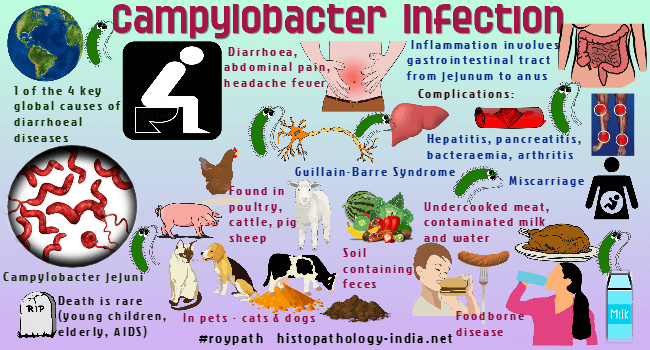|

Custom Search
|
|
Infectious Disease Online Pathology of Campylobacter Infection (Campylobacteriosis)
|

|
Campylobacter jejuni is a major cause of gastroenteritis worldwide, with increase in both incidence and prevalence over the past decade. Campylobacter infections have been associated most often with poultry, raw (unpasteurized) dairy products and untreated water, These organisms are flagellated, mainly spiral-shaped, “S”-shaped, or curved, rod-shaped, gram-negative bacteria. Campylobacter species are widely distributed in food animals such as poultry, cattle, pigs, sheep and ostriches; and in pets, including cats and dogs. The bacteria have also been found in shellfish. Campylobacter Enteritis: Campylobacter enteritis is acquired by eating improperly cleaned and cooked food, usually poultry, contaminated by Campylobacter jejuni, an organism that colonizes poultry. In one study, Campylobacter jejuni was cultured from the body cavities of more than half of fresh and frozen chickens and turkeys in 10 major cities around the world. Campylobacter jejuni, like Salmonella, are enteroinvasive and produce a spectrum of disease ranging from subclinical infection to severe dysentery. Illness appears 2 to 5 days after ingestion of contaminated food and lasts about 5 days. Symptoms include abdominal pain, diarrhea, nausea, vomiting, fever, and myalgia. Stools are malodorous and frequently bloody. Inflammation involves the gastrointestinal tract from jejunum to anus. Most patients have colonic crypt abscesses and ulcers resembling those in ulcerative colitis. Microscopically, the small bowel is edematous and hyperemic and is infiltrated with neutrophils, lymphocytes, and plasma cells. Comma-shaped organisms are seen in the intestinal mucosa and lamina propria. The disease is generally benign and self-limited. Other pathological lesions caused by Campylobacter jejuni : Less frequently, C. jejuni infections produce bacteremia, septic arthritis, and other extraintestinal symptoms. Complications such as hepatitis, pancreatitis (infections of liver and pancreas, respectively), and miscarriage have been reported with various degrees of frequency. Myocarditis can be a rare but severe complication of infectious disease and should be considered as a diagnosis in patients presenting with chest pain and elevated cardiac enzymes in the absence of underlying coronary disease. It can lead to dilated cardiomyopathy and congestive heart failure. There are only a few reported cases of myocarditis associated with Campylobacter infection. Infection with Campylobacter jejuni often precedes the Guillain-Barre syndrome and is associated with axonal degeneration, slow recovery, and severe residual disability. Campylobacter fetus infection: Another species, Campylobacter fetus, is an infrequent but clinically important opportunistic pathogen that causes localized infection as well as sepsis. The organism is an economically important cause of septic abortion and infertility in sheep and cattle. It has been isolated from vaginal secretions of cows, from the prepuce and ejaculate of bulls, and from the placenta and tissues of abortuses. Cases of spontaneous abortion and infertility in humans may thus be caused by Campylobacter fetus, especially in populations exposed to livestock. With reliable isolation and routine screening, Campylobacter species have emerged as the leading cause of acute bacterial enteritis. This infection is the fourth biggest cause of diarrhea-related diseases worldwide.
|
|
|

